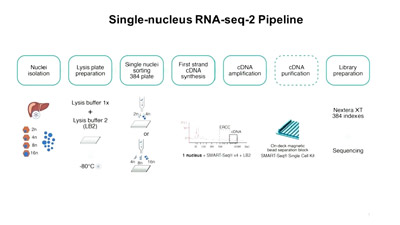Webinar: Pushing the limit of sensitivity for single-cell applications
Over the last decade, the RNA-seq field has grown tremendously thanks to surges in new technologies enhancing capabilities and boosting performance. With this in mind, SPT Labtech and Takara Bio have teamed up to present an insightful and educational webinar that examines the advantages of the SMART-Seq Single Cell Kit and how the industry-leading sensitivity of SSsc remains unmatched even when scaled with the mosquito HV genomics liquid-handling system, all resulting in higher efficiency with less hands-on time. These complementary solutions provide the opportunity for miniaturization of high-resolution libraries while yielding cost savings and improving ROI.

In this webinar, scientists from both SPT Labtech and Takara Bio present:
- An overview of the SMART-Seq Single Cell Kit, highlighting its unique advantages for full-length transcriptome analysis of single cells
- A deep-dive tour of the mosquito HV genomics liquid-handling system, exploring its versatility and miniaturization potential
- A demo, featuring protocol highlights
- A Q&A session
Webinar: Liver metabolic function, dissecting one cell at a time
Single-cell RNA-seq can help elucidate the role of pathogenic cell populations in the development and progression of chronic diseases. The speakers customized the Takara Bio SMART-Seq Single Cell Kit to develop a new method—single‑nucleus RNA‑seq2 (snRNA‑seq2). This technique further expands our knowledge of cellular heterogeneity by allowing deep characterization of nuclei isolated from frozen archived tissues.

In this webinar Dr. Martinez-Jimenez and Dr. Deligiannis present:
- Findings on the practical application of snRNA-seq2, a robust and reliable method for the analysis of the nuclear transcriptome from frozen tissues
- Cost-efficient miniaturization of snRNA-seq2 using liquid handling robots (i.e., the mosquito HV genomics system, SPT Labtech)
- Results that reveal, for the first time, a strong link between gene dosage and spatial location within the liver lobe

